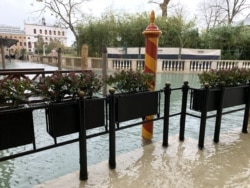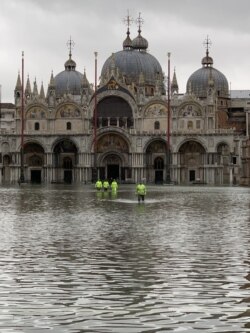Venice’s Hotel Association is urging tourists to visit the lagoon city without fear of high waters. Hoteliers say there have been many cancellations for Christmas and New Year's, and that bookings have dropped more than 45 percent following the exceptional high tide of November 12. They add that the city is as beautiful as ever and that all museums, shops and restaurants are functioning properly, as is transportation.
The Venice Hotel Association is calling on tourists all over the world to come to see for themselves the beauty of a city that has always lived with high tides, which hoteliers stressed, come and go. They fear that the many cancellations received by hotels following the extraordinary high tide of Nov. 12 has scared tourists away.
Venice's hotel association president, Vittorio Bonacini, said that tide certainly caused many problems in the city, with its hotels alone suffering $33 million in structural damage. He explained that the exceptionally high tide, which peaked at 187 centimeters (74 inches) and caused the worst flooding in the city in 50 years, was brought on by four factors: a rare lunar attraction, sirocco winds, extremely low atmospheric pressure on the high Adriatic Sea and winds blowing from the east at more than 126 kilometers (79 miles) an hour.
Bonacini added that the convergence of those factors was a lethal mix for the configuration of Venice and that the pictures captured at the time reminded everyone of just how fragile the city and its environment are. Bonacini said that what the pictures did not show is that the event lasted a mere one-and-a-half hours and that the tide had begun to recede after 3 hours.
Bonacini said that for centuries Venice has lived and experienced high water or “acqua alta," regulated by the cycles of the tides which rise and recede every 6 hours.
Hoteliers say that very quickly after a high tide event, life in the city is back to normal. They say it was obviously harder after the exceptional Nov. 12 event, but all Venetians came together and worked very hard to return the city back to normality in a very short time and, in spite of the damage, everyone resumed their ordinary daily lives.
The tides are not an earthquake, they say, but something that comes and goes, and Venice has always lived with them. As tides come and go, soon the water disappears from the flooded squares and streets, and it's business as usual at bars, restaurants and shops.
Hoteliers made clear that all activities function properly in the city and that Venice is safe again for everyone, including children and the elderly. They stressed that “acqua alta” is nothing traumatic, but that many hotel guests even consider it a fun experience.
Many hotels hand out high plastic boots to their guests as gifts so that they can avoid getting their feet wet and are not forced to use elevated walkways to enjoy a cup of coffee sitting at a bar in a flooded Saint Mark’s Square.






